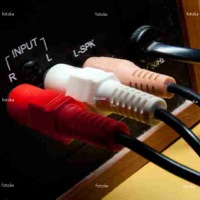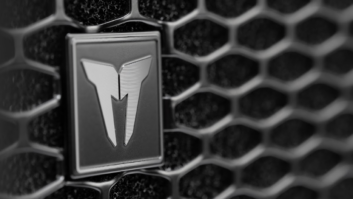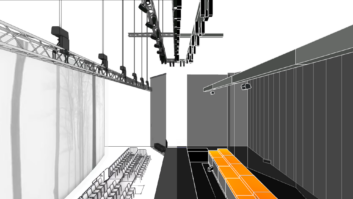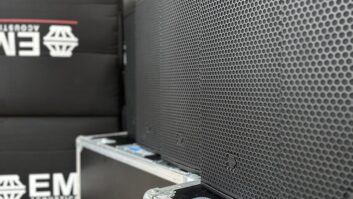
What goes around comes around, as the old saying goes, and that is undeniably true of Multichannel Audio Digital Interface (MADI). Despite being more than 20 years old – in other words, way past the point when we might reasonably have expected it to have shuffled off into the sunset – the audio communications protocol arguably enjoys greater levels of support than at any time in its history.
To which state of affairs one might reasonably ask, ‘why?’ With any number of distribution technologies being released into the market since, it seems fair to enquire as to the reasons for MADI’s ongoing popularity across segments. Although most prevalent in the broadcast market, MADI’s high channel count, reliability and open standard status have earned it widespread deployment in live and general install, too.
It’s debatable quite how long this will continue with new(ish) technologies like Dante and Ravenna – not to mention the AVB (Audio-?Video Bridging) project – rapidly gaining traction. But with some harbouring doubts about the imminence of a networking panacea, it’s unlikely that MADI will be consigned to the history books any time soon.
MADI: basics and benefits
So what is MADI and where did it come from? The result of a joint effort between SSL, Sony and Studer, the MADI open standard was originally documented by the Audio Engineering Society in 1991. Today, manufacturers offer varying levels of support for MADI, but most are generally united about its primary benefits, which fall into five categories:
1) Open Standard: MADI was formalised as AES10-1991 and subsequently updated 12 years later to AES10-2003. Hence Felix Krückels, senior product manager for Lawo’s mc? series, observes that one of MADI’s strengths is that “it is a standard which manufacturers can implement without any problems due to its open protocol [nature] and common understanding”. Nils Quak, who handles marketing & communications for Riedel, confirms that “the fact that it is a standard has made it very popular. MADI is a common denominator, [allowing] easy interfacing between manufacturers.”
2) Cable or Fibre Optic Implementation: Making it adept for both legacy and new installations, MADI can be sent down both single coaxial cable and fibre optic at distances of up to 1.3 miles (2km). But it was the format’s suitability for the former that helped it to achieve take-off. “Although AES10-2003 specifies fibre optic as an option, coaxial cables are by far the most popular transmission format for MADI. They made long runs possible way before the advent of low-latency Ethernet alternatives,” says Nicola Beretta, digital product specialist, Allen & Heath.
3) Channel Count: The technology’s support of serial digital transmission of 28, 56 or 64 channels (and sampling rates of up to 96kHz with resolution of up to 24 bits per channel), along with a limited amount of control data, ensures that it remains eminently viable for a host of applications. Accordingly, and alongside its open standard status, Dan Duffell, head of marketing at one of MADI’s co-devisers, Solid State Logic, highlights the format’s enduring popularity as a “high channel count lossless digital audio format”.
4) Ease of Installation: Single-coaxial or narrow-gauge optical implementations mean that MADI lends itself to restrictive installation spaces. “MADI is an excellent format for installers,” says Duffell, “particularly with optical MADI [which involves] a narrow-gauge cable that can easily sustain long cable runs.”
The need to send audio to multiple spaces has seen it enjoy a particularly exalted status in broadcast. Duffell notes: “Most of our broadcast clients install some form of audio routing system which needs to distribute and share audio between multiple production spaces and control rooms which house different types of equipment. Many of our clients also need to exchange data with SDI-based video distribution systems. MADI works incredibly well for combining systems and passing control data specifically because it is an open standard.”
Manuel Brico, RTS sales manager GAS & Balkan, highlights MADI’s suitability for exchanging audio signals between a venue’s audio router and/or mixing console and intercom system. “With one fibre cable, up to 64
high-quality real-time audio signals can be [distributed] between the two systems,” he says.
5) Reliability: If it’s not too facile a point, MADI simply works. Its 20-plus-year success story owes much to the fact that, as Midas/Klark Teknik brand development manager Richard Ferriday remarks, it is “a very popular protocol”. Beretta remarks that MADI is “standing up well over fast-changing technology” and alludes to the ongoing popularity of the M-MADI interface for use with Allen & Heath’s iLive digital mixing system.
MADI: the limitations
Most manufacturers approached by Installation were able to cite support accommodation of MADI – from Bosch with its RTS Intercom products, to Klark Teknik’s DN9652 Dual Network Bridge that allows two different protocols from a range including MADI to interface.
The second half of 2010, in particular, saw a cluster of new solutions hit the market, including SSL’s SDI-MADI
de-embedder interface and Avid’s HD MADI interface, among others, prompting Installation sister title PSNEurope to wonder at the time whether the technology was witnessing ‘a second coming’. Two years later, there is no indication of any imminent drop-off in interest… but that’s not to say that MADI doesn’t have its limitations, especially with channel count demands rising all the time.
1) Channel Count, Sampling Rate and Mono-Directionality: In 2013, MADI’s 64-channel maximum no longer seems particularly incredible. “The 64 channels are no longer the adequate performance level for modern productions with the requirements of a multitude of channels beyond MADI capacity,” says Krückels. This goes hand-in-hand with the sampling rate issue. “As soon as the sampling rate is doubled, the channel count is halved,” he adds.
While Midas/KT offers interfacing capability with MADI, Ferriday remarks: “All our digital mixing systems run 96K, so with MADI we could only have 32 channels down an AC connection at 96K, [which is rather limiting]. Consequently, we use [the subsequent AES-50 standard], which gives us 48 channels of audio at 96K down a single Cat5 cable. Plus, significantly, AES-50 is bidirectional, whereas MADI is mono-directional. To get a two-way MADI connection, you would have to run a pair (send and return) of cables.”
2) Routing, Distribution and Control: Although keenly acknowledging MADI’s benefits, Beretta confirms that “routing and distribution in a large facility can be a clumsy and expensive undertaking when compared to Cat5 and its siblings”. Also, while MADI can accommodate a limited amount of control data, it may not be sufficient for applications where increasingly large amounts of such information need to be conveyed – particularly in the live arena.
3) Point-to-Point: As talk turns to full networking as a default, there is the simple fact that MADI is “intrinsically point-to-point”, says Beretta. “It connects a source and a destination – it is not a networking protocol, which is where audio-over-Ethernet clearly wins.”
Far from the MADI crowd?
Most observers expect MADI to remain in demand for a long time to come – particularly in broadcast, where it is “truly embedded”, notes Ferriday. But increasingly, it will probably be used in tandem with other approaches.
James Gordon, managing director of DiGiCo, one of MADI’s earliest adopters, observes that it remains “very useful, but with the demands of today you need a large backbone behind it. You can look at network-based systems, but these tend to suffer from latency and cable-length limitations unless you go optical. Then you have security issues, so the network tends to be dedicated as well. On that basis we went for a dedicated optical network that was developed for audio. The Optocore system [which is a synchronous, redundant, optical ring network capable of transporting audio, video, data and word clock over long distances] has worked well for us and offers an unrivalled latency and redundancy.”
For DiGiCo, implementing Optocore has taken its systems into the realm of “a large network with 512 channels at 96kHz and five consoles sharing 14 racks of I/O… and still with the option to outbreak onto MADI”.
Also posing a challenge to MADI’s present standing is the groundswell of support for audio-over-IP. As distribution and control requirements become more demanding, the requirement for a proper network solution is certain to grow. And for many observers, this can best be implemented by using existing IP infrastructures, thereby minimising labour- and cost-intensive upgrade work.
“Digital audio distribution alongside LAN traffic eliminates additional infrastructure costs, and widespread cable routing is now the norm,” says Beretta. “A host of new networking technologies is bringing audio-over-Ethernet to a new level, using standard IP protocols and pioneering the AVB set of standards.”
Despite suffering from what is currently perceived in some quarters as a shortfall in availability of compliant products, the AVB (Audio-Video Bridging) project that involves the creation of standards for audio-over-Ethernet delivery is still generally expected to bring unprecedented uniformity to this area of networking.
The future?
Until such a time, individual approaches to the audio-over-IP debate are continuing to prosper, with two in particular widely perceived as successors to MADI. From Australian manufacturer Audinate, Dante is able to deliver 1,024 or 512 bidirectional channels at 48K/24-bit or 96K/24-bit, respectively, over Gigabit Ethernet.
Then there is Ravenna, developed by Lawo group company ALC NetworX. Although promoted most firmly towards broadcast – where its ability to operate without dedicated switches is felt to make it particularly conducive to integration into complex existing infrastructures – there are also potential applications in live and other parts of install. Once again, there is a significantly increased channel count; there are no specified limits with Ravenna, but with a typical Gbit LAN it is possible to run up to 500 audio channels at 24-bit/48kHz.
Specific details of the various approaches to audio-over-IP do vary but, suggests Beretta, “they have more in common than you might expect, and the ultimate goal of interoperability is not far away”.
In advance of that no doubt glorious day arriving, there will be plenty of sympathy with the opinion voiced by SSL’s Duffell, who appears to favour caution until there is a thoroughly ratified and “widely supported open standard for alternative approaches to high channel-count audio distribution”. He adds: “Particularly in broadcast, users need to be able to combine technology by different manufacturers in a simple and practical way, and at the moment other approaches still don’t really match MADI in that way.”
Every protocol has its day, of course, or as Beretta opines, “standards shift into legacy status gradually over time”. But, in an uncertain period, MADI is unquestionably reliable, and for that reason – ‘second coming’ or not – its short-to-mid term future is assured.
www.allen-heath.com
www.audinate.com
www.boschsecurity.com
www.digico.biz
www.klarkteknik.com
www.lawo.de
www.linkusa-inc.com
www.mercury-av.com
www.midasconsoles.com
ravenna.alcnetworx.com
www.riedel.net
www.rtsintercoms.com
www.solid-state-logic.com







